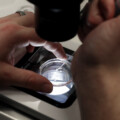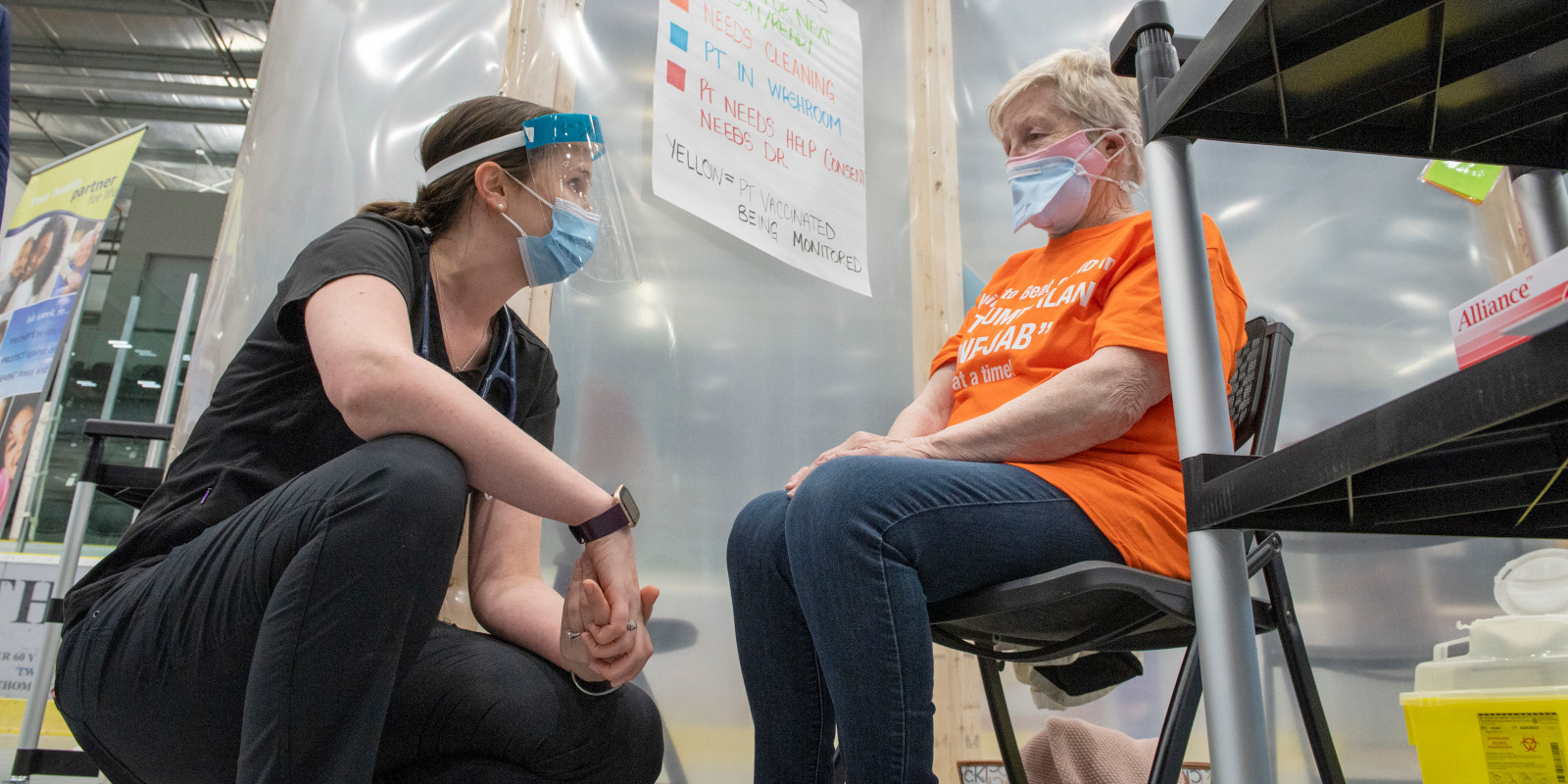This episode features Sean Speer in conversation with Neil Fraser, the Canadian President of Medtronic, a global medical devices company. They discuss the world of medical technology, the role of public policy in health, and the future that he sees for Canada and Canadians when it comes to leveraging new technologies to improve health outcomes.
You can listen to this episode of Hub Dialogues on Acast, Amazon, Apple, Google, Spotify, or YouTube. A transcript of the episode is available below.
Transcripts of our podcast episodes are not fully edited for grammar or spelling.
SEAN SPEER: Welcome to Hub Dialogues. I’m your host, Sean Speer, editor-at-large at The Hub. I’m honoured to be joined today by Neil Fraser, the Canadian president of Medtronic, which is a global medical devices company that produces, amongst other things, heart pacemakers. The company employs more than 90,000 people around the world, including more than a thousand here in Canada.
I’m grateful to speak with Neil about the world of medical technology, the role of public policy, and the future that he sees for Canada and Canadians when it comes to leveraging new technologies to improve health outcomes. Neil, thank you so much for joining us at Hub Dialogues.
NEIL FRASER: It’s my pleasure to be here. Thank you, Sean.
SEAN SPEER: Let’s start with a bit of a biographical sketch. You were previously at Alcan, where you were responsible for the introduction of aluminum in Canada, including curbside recycling programs. How does one go from aluminum to medical devices? What brought you to Medtronic?
NEIL FRASER: Ok well, Alcan, we don’t hear as much about it anymore, but it was a great Canadian company and a world leader in the production of aluminum. They’re now part of Rio Tinto globally, but it was a very interesting experience for me developing a new market specifically for aluminum cans, and the strategy was really through recycling and challenging some government regulations that didn’t allow aluminum into the packaging stream. The way we did that is we convinced them that it added tremendous value to recycling, and that led in to the approval of aluminum cans.
For me, I found that, while aluminum and aluminum cans are very interesting, it wasn’t what I wanted to spend my future doing, selling aluminum. I was very, very fortunate. At that time I met some people from Medtronic and I actually ended up meeting the founder of the company at one point. I had a background—I come from quite a medical family, not my immediate family, but I had aunts and uncles who were doctors and nurses.
Also, in my engineering training at UBC, I took some biomedical engineering electives, which I really enjoyed. It all came together for me, and this was a company that was focused on alleviating pain, restoring health, and extending life. To me, that gave me purpose, which is what I was really looking for.
SEAN SPEER: You mentioned the company and its long history. In fact, Medtronic started nearly 75 years ago. Why don’t you tell listeners a bit about the company, its key technologies, and its presence and activities in Canada?
NEIL FRASER: It’s an interesting story because actually, the first pacemaker was developed in Canada, at the University of Toronto, because they discovered that the heart responded to electrical impulses. But that pacemaker was a plug-in-the-wall device, which could never work with patients’ lifestyles. Also, it obviously could fail if there was a power failure. Moving over to Minnesota, where our founder worked as an electrical engineer repairing equipment at the university hospital, during one such power failure, unfortunately, a newborn baby died because the pacemaker failed because of a power failure.
So, the heart surgeon there, Dr. Lillehei asked our founder, Earl Bakken, to develop a wearable battery-powered pacemaker, so this would not happen again. He did that in the mid-’50s, and this later led to the development of fully implantable systems, and I suppose you could say that the rest is history. The basic model of working closely with highly specialized doctors on medical conditions, that really became the model for the company. Over the 75 years, we’ve really focused on finding novel technologies and using our deep understanding of anatomy and physiology to the development of devices for over 70 conditions.
Actually, today in the company, we treat two patients every two seconds. There are many, many areas that we’re involved in. As you said, we’re known for pacemakers, but we also make insulin pumps. We’re very involved in all kinds of surgery, including all kinds of general surgery, spine surgery, thoracic surgery, really, every kind of surgery. Recently, what’s really been exciting is we’re finding ways to do surgery through very small incisions, which allows for a much smaller wound, less infection, less blood loss, quicker recovery, and less use of hospital resources. That’s a very exciting development.
A good example would be heart valves that used to involve open chest surgery, now can be actually inserted through a very small incision in the leg, and a catheter can thread up through the aorta and implant a valve in the heart that is highly effective. The patient can go home, if not the same day then maybe the next day, and have almost immediate recovery. Also, I would mention that we’ve partnered a lot with folks in Canada.
We acquired a company called CryoCath in Montreal, which uses cold power to treat atrial fibrillation, and that’s become a world product for us. We have a large manufacturing facility there on the West Island. But also we’ve partnered with other Canadian firms to fill holes in our product line or where we can work together in a productive way. Some good examples, are Cloud DX out of Kitchener-Waterloo, who make remote physiologic sensors. We’ve worked with a company called Newtopia, that’s involved in diabetes prevention. We’re constantly on the outlook for talent and partners that we can work with. Canada’s got many, many small, medium enterprise companies that fill the bill.
SEAN SPEER: Neil, I want to ask you a question about your role as a Canadian president of a major global firm. Part of your job, ostensibly, is making the case within the company for investment or product mandates in Canada. In these activities, what do you view as the strengths of Canada that you can accentuate, and what are the weaknesses of the Canadian market that represents, in your mind, a vulnerability for your efforts to try to encourage Medtronic to invest more and expand its capacity within the country?
NEIL FRASER: First, I want to just clarify one point—I would classify myself as an influencer rather than a decision-maker as it relates to those kinds of product line investments because we work with 20 global operating units that have specific mandates in different areas. I would partner with them on any opportunity that I discovered in Canada. To talk about strengths and weaknesses, Canada is very strong in medical research. The University of Toronto, I believe, is number two among global universities for medical citations, which is an indicator of the amount of research that’s going on. I would say Canada’s really quite strong for a smaller country in this area of research.
Where we’re weak is that I think we can start up, but we’re weak at scaling up. What you tend to see is a lot of early exits, or people move their operation offshore, to the U.S. or elsewhere, when it’s time to expand. I think the weakness is just in that whole scaling up to a global operation. You don’t really see very many examples in our field of that occurring. We regularly work with physician inventors who have world-class ideas. If they’re not trying to create their own companies, then we can help them to achieve global impact. There are three examples. I mentioned CryoCath earlier, which came out of the University of Montreal and is now a world product and doing extremely well.
We also worked with a group at the University of Western Ontario on unexplained fainting. We developed something called Link, which is a black box of fainting. If a patient has unexplained fainting then the device is inserted into them and it has a two to three-year life span. It can analyze any future events of unexplained fainting, and it can identify the root cause of that. That could mean that they need a pacemaker or a defibrillator, or it could mean that it’s of neurologic origin, in which case there are other things that could be done.
The third example came out of the University of Toronto Sunnybrook Hospital, which is the product we call OsteoCool, which basically ablates spinal tumors and can allow patients greater comfort and better recovery than current alternatives for that problem.
SEAN SPEER: Neil, we’ll come to some public policy issues later in our conversation, but if I may just pick up the points you made about the tendency of promising Canadian startups to either sell out to larger firms or for the founder or founders to relocate to larger markets, do you have any views on what may be behind that tendency, and what, if anything, policymakers ought to be focusing on to encourage those promising firms to stay and grow and scale within Canada?
NEIL FRASER: Yes, absolutely. We’ve actually studied this. I worked with David Naylor in 2015 and we came out with a federal recommendation report on the subject. I think that the challenge we have is the host market, the Canadian health-care market, is not really a great market for innovative new products. It’s very slow at adopting them. It doesn’t really support entrepreneurs very well. Other markets, like the U.K. or Denmark and certainly the U.S., they have a much more robust appetite for new innovations that can improve patient outcomes.
They don’t have the barriers that we have, whether it’s slow medical fee changes or procurement that’s not really looking for innovative solutions. They’re just looking primarily to find things at a lower cost. Also, our health-care reimbursement of hospitals doesn’t really have an innovation budget per se. The same thing, keep doing what you’re doing, we’ll give you inflation, and that’s it. It doesn’t really allow for investment in new technology.
SEAN SPEER: You’ve described those mix of incentives and public policies as a “provider-centric health-care system” that as you say doesn’t incentivize the adoption of new and different technologies. May I just ask you to elaborate a bit on what you mean by provider-centric health-care system, and why is it that, as you say, these promising med-tech firms seem to have more success finding adoption in international health-care systems rather than our own here in Canada?
NEIL FRASER: I think the term that we’ve used a lot is rigidity. The way that we fund all these different streams, whether it’s fund health-care professionals, fund hospitals, fund departments within hospitals. It’s broadly referred to as silo funding. They’re given so much every year. They may be given inflation, but they’re not really encouraged either to find efficiencies or to find different ways of doing things. Just for an example, if I had a more expensive product that an operating room would purchase but it would save hospital stay or save intensive care stay, there’s no real incentive for the operating folks to give up the budget and say, “Oh, here you go.”
Actually, I suppose I got that backwards but for the critical care people to say, “Here’s more money to spend in the operating room,” because it’s their budget and they’re going to defend that to the death. We often say that there’s no constant currency. The money doesn’t translate from one budget to another the way it should to optimize innovation.
SEAN SPEER: Which, of course, begs the question, what should federal or provincial policy be doing to encourage the adoption and scaling of new technologies to improve the efficiency of the system and better patient outcomes? How, in other words, can public policy push back against the incentives that you’ve just outlined?
NEIL FRASER: I think that comes back to the patient-centric approach. Really, the budget needs to be based on the patient’s condition and the optimal care pathway for that patient. Therefore, it doesn’t really matter who’s involved and what they buy, it’s about what’s the most efficient way of treating a patient? We’re seeing that in other health-care systems. Part of it is, perhaps, it’s the discipline of insurance. If you have an insured system, then there is a pool of money per patient. There is an incentive to optimize their care within that.
You see that in the Dutch system very strongly, whereas in our system, although we’re insured, it’s insured in a big pool, but the money is allocated to the provider groups every year. It doesn’t follow the patient.
SEAN SPEER: To what extent, Neil, is the challenge that our decentralized form of medical procurement means that everyone is focused on costs, as you say, and no one in the system has an interest or a focus on experimenting with higher cost yet higher reward technologies? If so, how can we change that?
NEIL FRASER: First of all, I don’t see it as decentralized. There are different levels of decentralization, but the budgets that we deal with are largely at the provincial level. If it was truly decentralized, it would be at the patient level, but I’m even just saying at the hospital level would be better because the hospital has unique challenges with staffing and with delivering programs. If it was decentralized at that level, then they could optimize the care that they deliver at the hospital, but because it’s at the provincial level, no two hospitals are dealing with the same financial problems, are dealing with the same staffing problems. Therefore, they’re not able to invest for themselves in the best solutions.
SEAN SPEER: Neil, listeners will know about the health-care human resource challenges that we’re already facing and are bound to face more and more as the population ages and health-care demands grow. How much is med-tech a substitute for labour? In other words, to what extent can medical technologies help Canada cope with its labour shortages in the health-care system?
NEIL FRASER: I think that’s a good way of putting it because it’s not truly a substitute for labour, but it can offset some of the labour costs. One of the examples I gave you earlier about the heart valve, if technology can reduce the hospital stay by doing something minimally invasive, then that is reducing health human resource costs in the wards and in the recovery. But also a very new development is the use of robots to assist surgery. They can literally be like another pair of hands in the operating room. That would be another way of defraying shortages in staff, in the operating room, with technology.
SEAN SPEER: Let me ask one final public policy question, then I want to move to the future, where you have so many interesting ideas and thoughts. You’ve been deeply involved in the public policy process. You’ve participated, for instance, in sectoral discussions with the federal government. You mentioned earlier your association with the 2015 Health Innovation Report.
At this stage, what’s your sense, Neil? Do you think that policymakers are understanding the extent to which this provider-oriented or centric system, as you’ve called it, is standing in the way of reaping these benefits of greater adoption of new and emerging medical technologies? I guess, in other words, is there reason to think that the types of structural changes that we’ve been talking about today may be on the horizon?
NEIL FRASER: Well, certainly when you do health system comparisons, you can find examples of countries that are further down that journey, and National Health Service in the U.K. is a good example. Actually, many European jurisdictions. I know it wasn’t totally a home run, but Obamacare was an example of an initiative designed to reform health care, to make it accessible to all, and to do it very efficiently. The international comparisons are there. We also have international surveys that look at specific metrics that also show that Canada is not doing as well as its comparators.
Those would include the Commonwealth Fund survey out of New York, and the OECD, and there are other surveys done by different groups, whether the World Economic Forum or World Bank, that are providing these kinds of metrics. It’s just that within Canada, there’s not really a lot of discussion about these comparisons. I know we’re all very proud of the fairness of the Canadian system, that it’s theoretically available, equally available to all, and that is the ethic of the system. Challenging the actual performance, I think you have to accept that it’s not a short-term situation, it’s a long-term journey.
We’ve listened, over the years, as the National Health Service has gone through this. Sometimes you hear, “Oh, the National Health Service is terrible,” and this sort of thing. They’ve found a bump in the road to health-care reform, but they’re continually innovating and improving, whereas we remain rigid in Canada. I think that what we need is actually, political leaders with the courage and the stamina to see something like this through. Again, referring to the Obamacare situation, and presidents are elected on four-year terms, they stuck with that, actually, but it was terribly unpopular and it is actually continuing to grow and develop in the U.S., believe it or not, after all the terribly negative press.
Change is difficult. It’s difficult for all kinds of health-care professionals, can be difficult for the public, but ultimately, if you keep the goal in mind of what you’re trying to do, which is to make it more patient-centric and to improve productivity in doing that, then it’s very, very worthwhile. I would say that the pandemic, in many ways, has highlighted the shortcomings of the Canadian health-care system. We’re very optimistic that this can play a role in the direction of health-care reform in Canada, but we just need to see people that are willing to pick this up and run with it.
SEAN SPEER: Yes. Well said, Neil. One wonders if, in this case, the public may be ahead of the political class. That there may be more support for the types of structural reforms that we’ve been talking about on this episode and in previous ones, than a lot of political strategists and consultants and, ultimately, politicians understand. Part of that public mood is reflected by the profound benefits of medical technology that we’ve witnessed in the past two years in the form of the mRNA vaccines.
One gets the sense that we’re in a bit of a moment where the public would indeed support new investments and policy changes to catalyze the creation and adoption of new technologies. Why don’t you paint a picture of the future for our listeners? What are the possibilities in terms of technology adoption driving better patient outcomes? What areas of med-tech, Neil, are you most excited about?
NEIL FRASER: I’m going to go back to the pandemic first, and just provide one of the examples that I was referring to. The technologies for remote patient management have been around for a very long time if you want to include the telephone in that. More recently, Zoom, and of course, the potential for remote physiologic monitoring of patients’ conditions, which is much more recent, which, for example, Cloud DX I mentioned earlier, they are a leader in remote patient monitoring. During the pandemic, virtual care went from single-digit percentages to 90 percent because of patients didn’t want to go in to see a doctor, and doctors didn’t want to see patients just because of the risk of COVID.
This had been held back for many, many years because of concerns about overbilling, concerns that patients wouldn’t like it, and this sort of thing. But all those concerns were completely blown up during the pandemic. Patients loved getting remote care, it saved them driving downtown and parking and paying too much just to be in a hospital parking lot or whatever, and providers found they could see a lot of patients and provide a good level of care. Certainly not a panacea, because you can’t completely replace the in-person visit, of course, but there are many, many things that you can do remotely, and we’ve learned that. That would be an example that actually is coming true.
I don’t think we’re ever going back. I think that that will be part of the armamentarium of the medical system going forward. I if you can do it remotely, let’s do it remotely, and save everybody the time and energy. Broadening it, I think that we’ve talked about getting patient-centric. I would see, in the future, that we would have a health-care system that was really intensely focused on the patients, and their outcomes, and their journey, both in terms of prior to engaging the system, to sort of qualify where do they need to engage the system? What can they do to educate themselves and prepare themselves for it?
Having a very quick engagement with the health-care system, not involving a long hospital stay or anything like this. Then going home but staying connected, so that if there are any symptoms that emerge, you can manage them efficiently so that they don’t come back unnecessarily to the emergency department if it’s something that could be managed at home, this sort of thing. That would be the first thing, is, “Let’s get the patient at the centre of the system.”
I also think that data is implicit in all of this. Patient records need to attach to patients and follow them wherever they engage with the health-care system so that the health-care providers can be duly informed and don’t have to repeatedly ask all the same typical questions that you get when you go to a doctor’s office or hospital. But even more importantly, that they can see the history of the patient, what kind of conditions that they have or have had, what kind of restrictions they may have so that they can be very thoughtful in how they provide care.
I think also that patients have a terrible time getting access to their own records, believe it or not. In law patients do own their own data, but to actually get access to that data can be very, very difficult. I think the more that patients have access to their own data, the more that they can make informed choices as well. Educate themselves, be informed about what options of treatment they might have, and really be a true participant in their own care. I think that’s very important. I think that leads to improved productivity, by the way. Patients don’t want to unnecessarily waste resources either. They’re all taxpayers, and they’re all very, very thoughtful about what they want in their own care.
The other thing that we talked about is just about innovation. There really is a challenge in getting—and I’m talking about the Canadian health0care system specifically—there’s really a challenge, except when you have a pandemic on, of getting innovative new products, technologies, processes into the health-care system because of all these rigidities, these siloed budgets, and perhaps siloed thinking in the way processes and technologies are implemented in the system. I would like to see, in the future, that things, when they have sufficient evidence that justifies the expense and involving patients, that they could be immediately applied instead of having such tremendous lag time.
We talked about health-human resources. We really need to take heed of all these things we’re hearing. There’s a tremendous burden on health-human resources at all levels. Whether it’s the physicians, or the administrators, the nurses, everybody that’s involved. I think one of the things that’s very, very promising in this regard is artificial intelligence. If you have this data that follows the patient, you can also pool this data with patients with similar conditions.
You could do this locally, you could do this nationally. There are even groups now doing this globally, so that you can make the best decision with the patient about the course of treatment and what are the various options, and where is the best place to get that treatment? I think artificial intelligence can play a tremendous, tremendous role in the future of delivering optimal care for patients.
SEAN SPEER: That’s a very compelling picture of the future, Neil. It seems to me it’s precisely the kind of picture that policymakers will need to lean on to secure the kind of political capital to make some of the changes that we’ve been talking about.
Let me wrap up with something of a personal question. In addition to being the Canadian president of Medtronic, you’re also an enterprising podcast host yourself. For the past year or so, you’ve hosted your own podcast called The Next 100. What’s the basic thesis or purpose of the podcast, why did you decide to launch it, and how are you enjoying it?
NEIL FRASER: Yes, thank you. The podcast is called The Next 100, as you know, and that was inspired by the discovery of insulin, which happened, I guess it’s going on 101 years ago now, in Toronto. We didn’t want this milestone to pass without reflecting on what we’ve learned and thinking about what the future holds. We saw it as an opportunity to highlight innovators in the Canadian health-care system, and engage them, just like you did with me. Like, what does the future have in store for us? Just some of the things that we did, we spoke with Robert Reid, from Trillium Health Partners, on the concept of the medical home.
Ontario is experimenting with something called Ontario Health Teams, which is basically getting at the issue of primary care reform. The best health-care systems in the world have very strong primary care. The primary care physician takes responsibility for helping the patient navigate the health-care system. He had a lot to say about that. We also, with respect to diabetes, Dr. Margaret Lawson, from the Children’s Hospital of Eastern Ontario, and one of her patients, David Timms, just reflected on the role that technology is playing in diabetes care, which is very, very significant.
The idea that you’re continuously measuring blood sugar as a continuous variable, and responding to it using technology for the infusion of insulin to prevent hypoglycemic events that could land a patient in emergency or in a coma, even. That was a great one. Zayna Khayat, who’s a friend of mine, we’ve collaborated on a lot of things together. She’s a futurist and is currently working at Teladoc, Canada, basically on what we’ve discussed, which is the implementation of virtual care. We also thought we should, because we’re talking about the next hundred years, talk to some young students who aspire to be innovators.
We work with Youth Science Canada and Reni Barlow, who’s their executive director. It was just fascinating to hear the things that they were engaged in, things that they do at science fairs, but even more seriously, what they want to do with their future in health care. I was very inspired by Katharine Smart, who’s the current president of the CMA. She works as a pediatrician in rural Yukon, and I’m just really inspired by the way that she uses all of the virtual care tools available to her. She brings together teams to do consults with her patients so that they don’t have to travel to Vancouver or Edmonton to get care. She brings all the experts via video link into Yukon and helps her patients to get optimal care.
Dr. Sacha Bhatia is the executive lead for Ontario Health but also ran the centre for Virtual Care at Women’s College. He’s really a leading thinker on the potential for virtual care in patient-centric care. He had a colleague, Sonny Malhotra, who talked about automating all of the things outside of care but that surround the patient in terms of the physician office. That was a very interesting discussion as well. We covered a number of innovative topics that relate to the future of health care in Canada and globally. It was a great experience. I really enjoyed it. I’ve become a fan of podcasts.
SEAN SPEER: We’re honoured to have had you, Neil Fraser, the Canadian president of Medtronic on our podcast today. Thank you for joining us at Hub Dialogues to share your insights about Medtronic, but also some of these deeper questions about the adoption of medical technology in Canada’s health-care system, and ultimately improving patient outcomes across the country. Thank you so much, Neil.
NEIL FRASER: Thank you. It’s been a pleasure, Sean, to meet you.
Recommended for You

The Notebook by Theo Argitis: Carney’s One Big Beautiful Tax Cut, and fresh budget lessons from the U.K.

Christopher Snook: Is Canada sleepwalking into dystopia?

Rudyard Griffiths and Sean Speer: The fiscal hangover from the One Big Beautiful Bill hits Canada

‘A fiscal headache for Mark Carney’: The Roundtable on how Trump’s One Big Beautiful Bill could affect Canada



